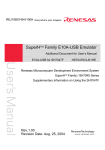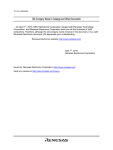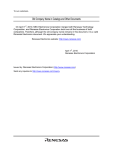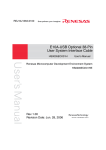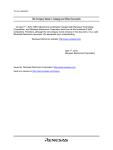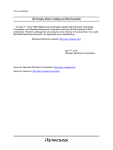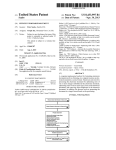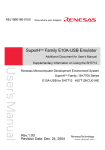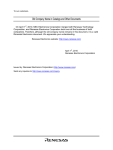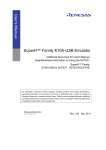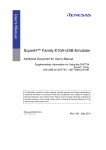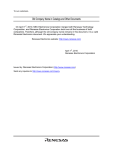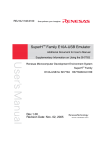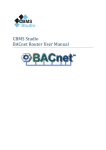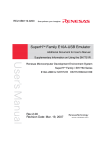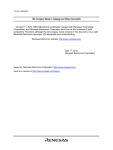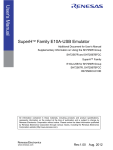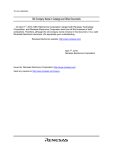Download SuperH Family E10A-USB Emulator Additional Document for User`s
Transcript
SuperH™ Family E10A-USB Emulator Additional Document for User's Manual Supplementary Information on Using the SH7047F SuperH™ Family / SH7047 Series E10A-USB for SH7047F HS7047KCU01HE All information contained in these materials, including products and product specifications, represents information on the product at the time of publication and is subject to change by Renesas Electronics Corporation without notice. Please review the latest information published by Renesas Electronics Corporation through various means, including the Renesas Electronics Corporation website (http://www.renesas.com). Rev. 2.00 Nov 2010 Notice 1. All information included in this document is current as of the date this document is issued. Such information, however, is subject to change without any prior notice. Before purchasing or using any Renesas Electronics products listed herein, please confirm the latest product information with a Renesas Electronics sales office. Also, please pay regular and careful attention to additional and different information to be disclosed by Renesas Electronics such as that disclosed through our website. 2. Renesas Electronics does not assume any liability for infringement of patents, copyrights, or other intellectual property rights of third parties by or arising from the use of Renesas Electronics products or technical information described in this document. No license, express, implied or otherwise, is granted hereby under any patents, copyrights or other intellectual property rights of Renesas Electronics or others. 3. You should not alter, modify, copy, or otherwise misappropriate any Renesas Electronics product, whether in whole or in part. 4. Descriptions of circuits, software and other related information in this document are provided only to illustrate the operation of semiconductor products and application examples. You are fully responsible for the incorporation of these circuits, software, and information in the design of your equipment. Renesas Electronics assumes no responsibility for any losses incurred by you or third parties arising from the use of these circuits, software, or information. 5. When exporting the products or technology described in this document, you should comply with the applicable export control laws and regulations and follow the procedures required by such laws and regulations. You should not use Renesas Electronics products or the technology described in this document for any purpose relating to military applications or use by the military, including but not limited to the development of weapons of mass destruction. Renesas Electronics products and technology may not be used for or incorporated into any products or systems whose manufacture, use, or sale is prohibited under any applicable domestic or foreign laws or regulations. 6. Renesas Electronics has used reasonable care in preparing the information included in this document, but Renesas Electronics does not warrant that such information is error free. Renesas Electronics assumes no liability whatsoever for any damages incurred by you resulting from errors in or omissions from the information included herein. 7. Renesas Electronics products are classified according to the following three quality grades: "Standard", "High Quality", and "Specific". The recommended applications for each Renesas Electronics product depends on the product's quality grade, as indicated below. You must check the quality grade of each Renesas Electronics product before using it in a particular application. You may not use any Renesas Electronics product for any application categorized as "Specific" without the prior written consent of Renesas Electronics. Further, you may not use any Renesas Electronics product for any application for which it is not intended without the prior written consent of Renesas Electronics. Renesas Electronics shall not be in any way liable for any damages or losses incurred by you or third parties arising from the use of any Renesas Electronics product for an application categorized as "Specific" or for which the product is not intended where you have failed to obtain the prior written consent of Renesas Electronics. The quality grade of each Renesas Electronics product is "Standard" unless otherwise expressly specified in a Renesas Electronics data sheets or data books, etc. "Standard": Computers; office equipment; communications equipment; test and measurement equipment; audio and visual equipment; home electronic appliances; machine tools; personal electronic equipment; and industrial robots. "High Quality": Transportation equipment (automobiles, trains, ships, etc.); traffic control systems; anti-disaster systems; anticrime systems; safety equipment; and medical equipment not specifically designed for life support. "Specific": Aircraft; aerospace equipment; submersible repeaters; nuclear reactor control systems; medical equipment or systems for life support (e.g. artificial life support devices or systems), surgical implantations, or healthcare intervention (e.g. excision, etc.), and any other applications or purposes that pose a direct threat to human life. 8. You should use the Renesas Electronics products described in this document within the range specified by Renesas Electronics, especially with respect to the maximum rating, operating supply voltage range, movement power voltage range, heat radiation characteristics, installation and other product characteristics. Renesas Electronics shall have no liability for malfunctions or damages arising out of the use of Renesas Electronics products beyond such specified ranges. 9. Although Renesas Electronics endeavors to improve the quality and reliability of its products, semiconductor products have specific characteristics such as the occurrence of failure at a certain rate and malfunctions under certain use conditions. Further, Renesas Electronics products are not subject to radiation resistance design. Please be sure to implement safety measures to guard them against the possibility of physical injury, and injury or damage caused by fire in the event of the failure of a Renesas Electronics product, such as safety design for hardware and software including but not limited to redundancy, fire control and malfunction prevention, appropriate treatment for aging degradation or any other appropriate measures. Because the evaluation of microcomputer software alone is very difficult, please evaluate the safety of the final products or system manufactured by you. 10. Please contact a Renesas Electronics sales office for details as to environmental matters such as the environmental compatibility of each Renesas Electronics product. Please use Renesas Electronics products in compliance with all applicable laws and regulations that regulate the inclusion or use of controlled substances, including without limitation, the EU RoHS Directive. Renesas Electronics assumes no liability for damages or losses occurring as a result of your noncompliance with applicable laws and regulations. 11. This document may not be reproduced or duplicated, in any form, in whole or in part, without prior written consent of Renesas Electronics. 12. Please contact a Renesas Electronics sales office if you have any questions regarding the information contained in this document or Renesas Electronics products, or if you have any other inquiries. (Note 1) "Renesas Electronics" as used in this document means Renesas Electronics Corporation and also includes its majorityowned subsidiaries. (Note 2) "Renesas Electronics product(s)" means any product developed or manufactured by or for Renesas Electronics. Regulatory Compliance Notices European Union regulatory notices This product complies with the following EU Directives. (These directives are only valid in the European Union.) CE Certifications: • Electromagnetic Compatibility (EMC) Directive 2004/108/EC EN 55022 Class A WARNING: This is a Class A product. In a domestic environment this product may cause radio interference in which case the user may be required to take adequate measures. EN 55024 • Information for traceability • Authorised representative Name: Renesas Electronics Corporation Address: 1753, Shimonumabe, Nakahara-ku, Kawasaki, Kanagawa, 211-8668, Japan • Manufacturer Name: Renesas Solutions Corp. Address: Nippon Bldg., 2-6-2, Ote-machi, Chiyoda-ku, Tokyo 100-0004, Japan • Person responsible for placing on the market Name: Renesas Electronics Europe Limited Address: Dukes Meadow, Millboard Road, Bourne End, Buckinghamshire, SL8 5FH, U.K. Environmental Compliance and Certifications: • Waste Electrical and Electronic Equipment (WEEE) Directive 2002/96/EC WEEE Marking Notice (European Union Only) Renesas development tools and products are directly covered by the European Union's Waste Electrical and Electronic Equipment, (WEEE), Directive 2002/96/EC. As a result, this equipment, including all accessories, must not be disposed of as household waste but through your locally recognized recycling or disposal schemes. As part of our commitment to environmental responsibility Renesas also offers to take back the equipment and has implemented a Tools Product Recycling Program for customers in Europe. This allows you to return equipment to Renesas for disposal through our approved Producer Compliance Scheme. To register for the program, click here “http://www.renesas.com/weee". United States Regulatory notices on Electromagnetic compatibility FCC Certifications (United States Only): This equipment has been tested and found to comply with the limits for a Class A digital device, pursuant to Part 15 of the FCC Rules. These limits are designed to provide reasonable protection against harmful interference when the equipment is operated in a commercial environment. This equipment generates, uses, and can radiate radio frequency energy and, if not installed and used in accordance with the instruction manual, may cause harmful interference to radio communications. Operation of this equipment in a residential area is likely to cause harmful interference in which case the user will be required to correct the interference at his own expense. CAUTION: Changes or modifications not expressly approved by the party responsible for compliance could void the user's authority to operate the equipment. Table of Contents Section 1 Connecting the Emulator with the User System .................................................................... 1 1.1 1.2 1.3 1.4 1.5 Components of the Emulator .................................................................................................................................... 1 Connecting the E10A-USB Emulator with the User System .................................................................................... 3 Installing the H-UDI Port Connector on the User System ........................................................................................ 4 Pin Assignments of the H-UDI Port Connector ........................................................................................................ 4 Recommended Circuit between the H-UDI Port Connector and the MCU .............................................................. 7 1.5.1 Recommended Circuit (36-Pin Type) ............................................................................................................ 7 1.5.2 Recommended Circuit (14-Pin Type) .......................................................................................................... 12 Section 2 Specifications of the Software when Using the SH7047F................................................... 15 2.1 2.2 Differences between the SH7047F and the Emulator ............................................................................................. 15 Specific Functions for the Emulator when Using the SH7047F ............................................................................. 19 2.2.1 Break Condition Functions........................................................................................................................... 20 2.2.2 AUD Functions ............................................................................................................................................ 22 2.2.3 Notes on Displaying the [Trace] Window .................................................................................................... 24 2.2.4 Notes on Using the JTAG Clock (TCK) ...................................................................................................... 24 2.2.5 Notes on Setting the [Breakpoint] Dialog Box............................................................................................. 25 SuperH™ Family E10A-USB Emulator Section 1 Connecting the Emulator with the User System Section 1 Connecting the Emulator with the User System 1.1 Components of the Emulator The E10A-USB emulator supports the SH7047F. The supported operating modes are as follows: ⎯ MCU expansion mode 2 ⎯ Single-chip mode Note: When the SH7047F is used, set the FWP pin to 0 (low). To select MCU expansion mode 2, select the clock mode in FWP = 0 and MD3,2, and set MD1 = 1 and MD0 = 0. To select the single-chip mode, select the clock mode in FWP = 0 and MD3,2, and set MD1 = 1 and MD0 = 1. Table 1.1 lists the components of the emulator. R20UT0371EJ0200 Rev. 2.00 Nov 18, 2010 Page 1 of 26 SuperH™ Family E10A-USB Emulator Section 1 Connecting the Emulator with the User System Table 1.1 Components of the Emulator Classification Component Hardware Appearance Quantity Emulator box 1 User system interface cable User system interface cable 1 USB cable 1 1 Remarks HS0005KCU01H: Depth: 65.0 mm, Width: 97.0 mm, Height: 20.0 mm, Mass: 72.9 g or HS0005KCU02H: Depth: 65.0 mm, Width: 97.0 mm, Height: 20.0 mm, Mass: 73.7 g 14-pin type: Length: 20 cm, Mass: 33.1 g 36-pin type: Length: 20 cm, Mass: 49.2 g (only for HS0005KCU02H) Length: 150 cm, Mass: 50.6 g Software E10A-USB emulator 1 HS0005KCU01SR, setup program, TM SuperH Family HS0005KCU01HJ, HS0005KCU01HE, E10A-USB Emulator User’s Manual, HS7047KCU01HJ, Supplementary HS7047KCU01HE, Information on Using the SH7047F*, and Test program manual HS0005TM01HJ, and for HS0005KCU01H HS0005TM01HE and HS0005KCU02H (provided on a CD-R) Note: Additional document for the MCUs supported by the emulator is included. Check the target MCU and refer to its additional document. R20UT0371EJ0200 Rev. 2.00 Nov 18, 2010 Page 2 of 26 SuperH™ Family E10A-USB Emulator 1.2 Section 1 Connecting the Emulator with the User System Connecting the E10A-USB Emulator with the User System To connect the E10A-USB emulator (hereinafter referred to as the emulator), the H-UDI port connector must be installed on the user system to connect the user system interface cable. When designing the user system, refer to the recommended circuit between the H-UDI port connector and the MCU. In addition, read the E10A-USB emulator user's manual and hardware manual for the related device. Table 1.2 shows the type number of the emulator, the corresponding connector type, and the use of AUD function. Table 1.2 Type Number, AUD Function, and Connector Type Type Number Connector AUD Function HS0005KCU01H, HS0005KCU02H 14-pin connector Not available HS0005KCU02H 36-pin connector Available The H-UDI port connector has the 36-pin and 14-pin types as described below. Use them according to the purpose of the usage. 1. 36-pin type (with AUD function) The AUD trace function is supported. A large amount of trace information can be acquired in realtime. The window trace function is also supported for acquiring memory access in the specified range (memory access address or memory access data) by tracing. 2. 14-pin type (without AUD function) The AUD trace function cannot be used because only the H-UDI function is supported. For tracing, only the internal trace function is supported. Since the 14-pin type connector is smaller than the 36-pin type (1/2.5), the area where the connector is installed on the user system can be reduced. R20UT0371EJ0200 Rev. 2.00 Nov 18, 2010 Page 3 of 26 SuperH™ Family E10A-USB Emulator 1.3 Section 1 Connecting the Emulator with the User System Installing the H-UDI Port Connector on the User System Table 1.3 shows the recommended H-UDI port connectors for the emulator. Table 1.3 Recommended H-UDI Port Connectors Connector Type Number Manufacturer Specifications 36-pin connector DX10M-36S Hirose Electric Co., Ltd. Screw type Lock-pin type DX10M-36SE, DX10G1M-36SE 14-pin connector 2514-6002 3M Limited 14-pin straight type Note: When designing the 14-pin connector layout on the user board, do not place any components within 3 mm of the H-UDI port connector. When designing the 36-pin connector layout on the user board, do not connect any components under the H-UDI connector. 1.4 Pin Assignments of the H-UDI Port Connector Figures 1.1 and 1.2 show the pin assignments of the 36-pin and 14-pin H-UDI port connectors, respectively. Note: Note that the pin number assignments of the H-UDI port connector shown on the following pages differ from those of the connector manufacturer. R20UT0371EJ0200 Rev. 2.00 Nov 18, 2010 Page 4 of 26 SuperH™ Family E10A-USB Emulator SH7047F Pin No. Pin No. Signal Input/ Output *1 1 AUDCK I/O 79 2 GND 3 AUDATA0 I/O 92 4 GND 5 AUDATA1 6 GND 7 AUDATA2 8 GND 9 AUDATA3 10 GND Section 1 Connecting the Emulator with the User System Note Pin No. Signal Input/ Output *1 19 TMS Input 59 20 GND Input 58 Input 61 Output 60 27 *2 /ASEBRKAK Output 11 21 *2 /TRST SH7047F Pin No. Note 22*5 GND I/O 90 I/O 88 I/O 86 23 TDI 24 GND 25 TDO 26 GND 28 11 *2 /AUDSYNC 12 GND 13 AUDRST 14 GND 15 AUDMD 16 GND 17 TCK 18 GND I/O 78 Input 81 29 *4 UVCC 30 Input 63 Output User reset 87 GND 33 *3 GND 80 Output GND 31 *2 /RES 32 Input GND 34 GND 35 N.C. 36 GND Output Notes: 1. Input to or output from the user system. 2. The slash (/) means that the signal is active-low. 3. The emulator monitors the GND signal of the user system and detects whether or not the user system is connected. 4. If the VccQ pin is not connected to the UVCC, the I/O voltage of the user system interface will be fixed to 5.0 V. 5. The /DBGMD pin must be 0 when the emulator is connected and 1 when the emulator is not connected, respectively. (1) When the emulator is used: /DBGMD = 0 (ASE mode) (2) When the emulator is not used: /DBGMD = 1 (normal mode) To allow the /DBGMD pin to be GND by connecting the user system interface cable, connect pin 22 directly to the /DBGMD pin. Do not ground the pin. H-UDI port connector (top view) Edge of the board (connected to the connector) φ 0.7+0.1 0 36 1 3 9.0 1.905 1.1 4.5 2 φ 2.8+0.1 0 4 (Pin 1 mark) 35 1.27 4.09 M2.6 x 0.45 H-UDI port connector (front view) 4.8 H-UDI port connector (top view) 3.9 37.61 43.51 : Pattern inhibited area 0.3 9.0 21.59 Unit: mm Figure 1.1 Pin Assignments of the H-UDI Port Connector (36 Pins) R20UT0371EJ0200 Rev. 2.00 Nov 18, 2010 Page 5 of 26 SuperH™ Family E10A-USB Emulator Pin No. Section 1 Connecting the Emulator with the User System Input/ Output*1 Signal TCK SH7047F Pin No. Input 63 /TRST Input 58 3 TDO Output 60 4*2 /ASEBRKAK Output 11 5 TMS Input 59 6 TDI Input 61 7*2 /RES Output 87 8* 6 N.C. 9*5 11*4 (GND) 1 2* 2 UVCC 10, 12, GND and 13 Output GND 14*3 Notes: 1. Input to or output from the user system. 2. The slash (/) means that the signal is active-low. 3. The emulator monitors the GND signal of the user system and detects whether or not the user system is connected. 4. If the VccQ pin is not connected to the UVCC, the I/O voltage of the user system interface will be fixed to 5.0 V. 5. The /DBGMD pin must be 0 when the emulator is connected and 1 when the emulator is not connected, respectively. (1) When the emulator is used: /DBGMD = 0 (ASE mode) (2) When the emulator is not used: /DBGMD = 1 (normal mode) To allow the /DBGMD pin to be GND by connecting the user system interface cable, connect pin 9 directly to the /DBGMD pin. Do not ground the pin. 6. This pin can be connected to GND. Pin 1 mark H-UDI port connector (top view) 25.0 23.0 6 x 2.54 = 15.24 (2.54) H-UDI port connector (top view) Pin 8 Pin 1 Pin 14 Pin 7 0.45 Pin 1 mark Unit: mm Figure 1.2 Pin Assignments of the H-UDI Port Connector (14 Pins) R20UT0371EJ0200 Rev. 2.00 Nov 18, 2010 Page 6 of 26 SuperH™ Family E10A-USB Emulator 1.5 1.5.1 Section 1 Connecting the Emulator with the User System Recommended Circuit between the H-UDI Port Connector and the MCU Recommended Circuit (36-Pin Type) Figure 1.3 shows a recommended circuit for connection between the H-UDI and AUD port connectors (36 pins) and the MCU when the emulator is in use. Figure 1.4 shows a circuit for connection when UVCC is not connected. Notes: 1. Do not connect anything to the N.C. pins of the H-UDI port connector. 2. The /DBGMD pin must be 0 when the emulator is connected and 1 when the emulator is not connected, respectively. (1) When the emulator is used: /DBGMD = 0 (ASE mode) (2) When the emulator is not used: /DBGMD = 1 (normal mode) Figures 1.3 and 1.4 show examples of circuits that allow the /DBGMD pin to be GND (0) whenever the emulator is connected by using the user system interface cable. When the /DBGMD pin is changed by switches, etc., ground pin 22. Do not connect this pin to the /DBGMD pin. 3. The FWP pin must be 0 (low) by switching jumper pins when the emulator is used. 4. When a network resistance is used for pull-up, it may be affected by a noise. Separate TCK from other resistances. 5. When the emulator is used, the AUDCK pin must be an end resistance (pulled up or down by a resistance of several kilo-ohms) because it may be affected by a reflected noise from the user system interface cable. 6. The pattern between the H-UDI port connector and the MCU must be as short as possible. Do not connect the signal lines to other components on the board. 7. When the power supply of the user system is turned off, supplying VccQ of the user system to the UVCC pin reduces the leakage current from the emulator to the user system. Buffers that can be activated by the internal power supply or user power supply (changed by the switch) are installed in the interface circuit of the emulator. If the user power is selected for supply to the UVCC pin, the buffers will not be activated unless supplied with user power. Thus no current flows from the user interface when the power supply of the user system is turned off. The I/O voltage level of the user system interface can be the same as that of the VccQ. To operate the emulator with low voltage (lower than 5.0 V), the VccQ must be supplied to the UVCC pin. Make the emulator’s switch settings so that the VccQ will be supplied (SW2 = 1 and SW3 = 1) (as shown in figure 1.3). 8. The resistance values shown in figures 1.3 and 1.4 are recommended. R20UT0371EJ0200 Rev. 2.00 Nov 18, 2010 Page 7 of 26 SuperH™ Family E10A-USB Emulator 9. Section 1 Connecting the Emulator with the User System For the pin processing in cases where the emulator is not used, refer to the hardware manual of the related MCU. R20UT0371EJ0200 Rev. 2.00 Nov 18, 2010 Page 8 of 26 SuperH™ Family E10A-USB Emulator Section 1 Connecting the Emulator with the User System When the circuit is connected as shown in figure 1.3, the switches of the emulator are set as SW2 TM = 1 and SW3 = 1. For details, refer to section 3.8, Setting the DIP Switches, in the SuperH Family E10A-USB Emulator User’s Manual. VccQ = 5.0 V (I/O power supply) VccQ VccQ VccQ Pulled-up at 4.7 kΩ or more (all) H-UDI port connector (36-pin type) 2 4 6 8 10 12 14 16 18 20 22 24 26 28 30 32 34 36 GND AUDCK GND AUDATA0 GND AUDATA1 GND AUDATA2 GND AUDATA3 GND AUDSYNC GND AUDRST GND AUDMD GND TCK GND TMS GND TRST GND TDI GND TDO GND ASEBRKAK GND GND UVCC RESET GND GND GND N.C. 1 kΩ SH7047F 1 79 3 92 5 90 7 88 9 86 11 78 13 81 15 80 17 63 19 59 21 58 23 61 25 60 27 11 AUDCK AUDATA0 AUDATA1 AUDATA2 AUDATA3 AUDSYNC AUDRST AUDMD TCK TMS TRST TDI TDO ASEBRKAK 29 31 87 33 16 35 RES DBGMD 2 kΩ Reset signal 83 FWP Jumper pins switched * User system Figure 1.3 Recommended Circuit for Connection between the H-UDI Port Connector and MCU when the Emulator is in Use (36-Pin Type UVCC Connected) Note: The FWP pin must be 0 (low) by switching jumper pins when the emulator is used. R20UT0371EJ0200 Rev. 2.00 Nov 18, 2010 Page 9 of 26 SuperH™ Family E10A-USB Emulator Section 1 Connecting the Emulator with the User System When the circuit is connected as shown in figure 1.4, the switches of the emulator are set as SW2 TM = 0 and SW3 = 1. For details, refer to section 3.8, Setting the DIP Switches, in the SuperH Family E10A-USB Emulator User’s Manual. VccQ = 5.0 V (I/O power supply) VccQ VccQ Pulled-up at 4.7 kΩ or more (all) H-UDI port connector (36-pin type) 2 4 6 8 10 12 14 16 18 20 22 24 26 28 30 32 34 36 GND AUDCK GND AUDATA0 GND AUDATA1 GND AUDATA2 GND AUDATA3 GND AUDSYNC GND AUDRST GND AUDMD GND TCK GND TMS GND TRST GND TDI GND TDO GND ASEBRKAK GND N.C. GND RESET GND GND GND N.C. 1 kΩ SH7047F 1 79 3 92 5 90 7 88 9 86 11 78 13 81 15 80 17 63 19 59 21 58 23 61 25 60 27 11 AUDCK AUDATA0 AUDATA1 AUDATA2 AUDATA3 AUDSYNC AUDRST AUDMD TCK TMS TRST TDI TDO ASEBRKAK 29 *2 31 87 33 16 35 2 kΩ Reset signal 83 RES DBGMD FWP Jumper pins switched *1 User system Figure 1.4 Circuit for Connection between the H-UDI Port Connector and MCU when the *2 Emulator is in Use (36-Pin Type UVCC Not Connected ) R20UT0371EJ0200 Rev. 2.00 Nov 18, 2010 Page 10 of 26 SuperH™ Family E10A-USB Emulator Section 1 Connecting the Emulator with the User System Notes: 1. The FWP pin must be 0 (low) by switching jumper pins when the emulator is used. 2. When UVCC is not connected and the user system is turned off, note that the leakage current flows from the emulator to the user system. R20UT0371EJ0200 Rev. 2.00 Nov 18, 2010 Page 11 of 26 SuperH™ Family E10A-USB Emulator 1.5.2 Section 1 Connecting the Emulator with the User System Recommended Circuit (14-Pin Type) Figure 1.5 shows a recommended circuit for connection between the H-UDI and AUD port connectors (14 pins) and the MCU when the emulator is in use. Figure 1.6 shows a circuit for connection when UVCC is not connected. Notes: 1. Do not connect anything to the N.C. pins of the H-UDI port connector. 2. The /DBGMD pin must be 0 when the emulator is connected and 1 when the emulator is not connected, respectively. (1) When the emulator is used: /DBGMD = 0 (ASE mode) (2) When the emulator is not used: /DBGMD = 1 (normal mode) Figures 1.5 and 1.6 show examples of circuits that allow the /DBGMD pin to be GND (0) whenever the emulator is connected by using the user system interface cable. When the /DBGMD pin is changed by switches, etc., ground pin 9. Do not connect this pin to the /DBGMD pin. 3. The FWP pin must be 0 (low) by switching jumper pins when the emulator is used. 4. When a network resistance is used for pull-up, it may be affected by a noise. Separate TCK from other resistances. 5. The pattern between the H-UDI port connector and the MCU must be as short as possible. Do not connect the signal lines to other components on the board. 6. When the power supply of the user system is turned off, supplying VccQ of the user system to the UVCC pin reduces the leakage current from the emulator to the user system. A level shifter that is activated by the internal power supply or user power supply (changed by the switch) is installed in the interface circuit of the emulator. If the user power is supplied to the UVCC pin, the level shifter is not activated as long as no user power is supplied. When the power supply of the user system is turned off, no current flows from the user interface. The I/O voltage level of the user system interface can be the same as that of the VccQ. To operate the emulator with low voltage (lower than 5.0 V), the VccQ must be supplied to the UVCC pin. Make the emulator’s switch settings so that the VccQ will be supplied (SW2 = 1 and SW3 = 1) (as shown in figure 1.5). 7. The resistance values shown in figures 1.5 and 1.6 are recommended. 8. For the pin processing in cases where the emulator is not used, refer to the hardware manual of the related MCU. R20UT0371EJ0200 Rev. 2.00 Nov 18, 2010 Page 12 of 26 SuperH™ Family E10A-USB Emulator Section 1 Connecting the Emulator with the User System When the circuit is connected as shown in figure 1.5, the switches of the emulator are set as SW2 TM = 1 and SW3 = 1. For details, refer to section 3.8, Setting the DIP Switches, in the SuperH Family E10A-USB Emulator User’s Manual. VccQ = 5.0 V (I/O power supply) VccQ Pulled-up at 4.7 kΩ or more (all) VccQ H-UDI port connector (14-pin type) TCK 9 10 (GND) GND TRST 13 14 GND TMS GND TDI GND 63 2 58 3 60 4 11 5 59 6 61 7 87 TDO ASEBRKAK 12 SH7047F 1 RESET N.C. 8 TCK TRST TDO ASEBRKAK TMS TDI RES 16 *2 Reset signal 11 UVCC DBGMD 83 FWP Jumper pins switched *1 User system Figure 1.5 Recommended Circuit for Connection between the H-UDI Port Connector and MCU when the Emulator is in Use (14-Pin Type UVCC Connected) Notes: 1. The FWP pin must be 0 (low) by switching jumper pins when the emulator is used. 2. This pin can be connected to GND. R20UT0371EJ0200 Rev. 2.00 Nov 18, 2010 Page 13 of 26 SuperH™ Family E10A-USB Emulator Section 1 Connecting the Emulator with the User System When the circuit is connected as shown in figure 1.6, the switches of the emulator are set as SW2 TM = 0 and SW3 = 1. For details, refer to section 3.8, Setting the DIP Switches, in the SuperH Family E10A-USB Emulator User’s Manual. VccQ = 5.0 V (I/O power supply) Pulled-up at 4.7 kΩ or more (all) VccQ H-UDI port connector (14-pin type) TCK 9 10 (GND) GND TRST 13 GND TMS GND TDI 14 GND 63 2 58 3 60 4 11 5 59 6 61 7 87 TDO ASEBRKAK 12 SH7047F 1 RESET N.C. N.C. 8 TCK TRST TDO ASEBRKAK TMS TDI RES 16 *3 Reset signal 11 *2 DBGMD 83 FWP Jumper pins switched *1 User system Figure 1.6 Circuit for Connection between the H-UDI Port Connector and MCU when the *2 Emulator is in Use (14-Pin Type UVCC Not Connected ) Notes: 1. The FWP pin must be 0 (low) by switching jumper pins when the emulator is used. 2. When UVCC is not connected and the user system is turned off, note that the leakage current flows from the emulator to the user system. 3. This pin can be connected to GND. R20UT0371EJ0200 Rev. 2.00 Nov 18, 2010 Page 14 of 26 SuperH™ Family E10A-USB Emulator Section 2 Specifications of the Software when Using the SH7047F Section 2 Specifications of the Software when Using the SH7047F 2.1 Differences between the SH7047F and the Emulator 1. When the emulator system is initiated, it initializes the general registers and part of the control registers as shown in table 2.1. The initial values of the actual SH7047F registers are undefined. When the emulator is initiated from the workspace, a value to be entered is saved in a session. Table 2.1 Register Initial Values at Emulator Link Up Register Emulator at Link Up R0 to R14 H'00000000 R15 (SP) Value of the SP in the vector address table PC Value of the PC in the vector address table SR H'000000F0 GBR H'00000000 VBR H'00000000 MACH H'00000000 MACL H'00000000 PR H'00000000 2. The emulator uses the H-UDI; do not access the H-UDI. R20UT0371EJ0200 Rev. 2.00 Nov 18, 2010 Page 15 of 26 SuperH™ Family E10A-USB Emulator Section 2 Specifications of the Software when Using the SH7047F 3. Low-Power States (Sleep, Software Standby, and Module Standby) For low-power consumption, the SH7047F has sleep, software standby, and module standby states. When the emulator is used, the sleep mode can be cleared with either the normal clearing function or with the forced break. Note that, however, if a command has been entered in software standby mode or module standby mode, no commands can be used from the emulator since the mode is cleared only with the normal clearing function. Notes: The memory must not be accessed or modified in sleep state. 1. Do not set the MSTP2 or MSTP27 bit to 1 in the MSTCR2 register (address H’FFFF861E) nor the RAME bit to 0 in the SYSCR register (address H’FFFF8618), since doing so may prevent the emulator from operating correctly. 2. When the HS0005KCU02H is used, do not set the following bits to 0: the MSTP3 bit in the MSTCR2 register (address H’FFFF861E) and the AUDSRST bit in the SYSCR register (address H’FFFF8618). The AUD function cannot be used. 4. Reset Signals (/RES) The RESET signal can be accepted during user program break, when the peripheral modules are reset. Since the PC, SR, and SP registers are not initialized, reset them and execute the GO command when the user program is executed from the reset vector. Note: Do not break the user program when the /RES, /BREQ, and /WAIT pins are being low. A TIMEOUT error will occur. The TIMEOUT error will also occur at memory access when the /BREQ and /WAIT pins are fixed low during break. 5. Data Transfer Controller (DTC) The DTC operates even in the command wait state. When a data transfer request is generated, the DTC executes a DMA transfer. 6. Memory Access during User Program Execution When a memory is accessed from the memory window, etc. during user program execution, the user program is resumed after it has stopped in the emulator to access the memory. Therefore, realtime emulation cannot be performed. The stopping time of the user program is as follows: Environment: ® Host computer: 650 MHz (Pentium III) ® OS: Windows 2000 SH7047F: 40 MHz (CPU clock) JTAG clock: 10 MHz (TCK clock) When a one-byte memory is read from the command-line window, the stopping time will be about 35 ms. R20UT0371EJ0200 Rev. 2.00 Nov 18, 2010 Page 16 of 26 SuperH™ Family E10A-USB Emulator Section 2 Specifications of the Software when Using the SH7047F 7. Memory Access during User Program Break Memory write operations are enabled for the RAM area and the internal flash memory. Therefore, an operation such as memory write or BREAKPOINT should be set only for the RAM area and the internal flash memory. 8. Multiplexed Functions The AUD and H-UDI pins are multiplexed as shown in table 2.2. Those functions cannot be used when the emulator is used. Table 2.2 Multiplexed Functions Function 1 Function 2 PA15/CK/POE6/BACK TRST (H-UDI) PA14/RD/POE5 TMS (H-UDI) PA13/POE4/BREQ TDO (H-UDI) PA12/WRL/UBCTRG TDI (H-UDI) PA10/CS0/RD/SCK2 TCK (H-UDI) PD7/D7* AUDSYNC (AUD) PD6/D6* AUDCK (AUD) PD5/D5* AUDMD (AUD) PD4/D4* AUDRST (AUD) PD3/D3* AUDATA3 (AUD) PD2/D2/SCK2* AUDATA2 (AUD) PD1/D1/TXD2* AUDATA1 (AUD) PD0/D0/RXD2* AUDATA0 (AUD) Note: Function 1 can be used when the AUD pins of the MCU are not connected to the emulator. 9. Loading Sessions Information in [JTAG clock] of the [Configuration] dialog box cannot be recovered by loading sessions. Thus the TCK value will be 0.625 MHz. 10. [IO] Window • Display and modification For each Watchdog Timer register, there are two registers to be separately used for write and read operations. R20UT0371EJ0200 Rev. 2.00 Nov 18, 2010 Page 17 of 26 SuperH™ Family E10A-USB Emulator Section 2 Specifications of the Software when Using the SH7047F Table 2.3 Watchdog Timer Registers Register Name Usage Register TCSR (R) Read Watchdog timer control/status register TCNT (R) Read Watchdog timer counter RSTCSR (R) Read Reset control/status register TCSR (W) Write Watchdog timer control/status register TCNT (W) Write Watchdog timer counter RSTCSR (W) Write Reset control/status register • The internal I/O registers can be accessed from the [IO] window. After the I/O-register definition file is created, the MCU’s specification may be changed. If each I/O register in the I/O-register definition file differs from addresses described in the hardware manual, change the I/O-register definition file according to the description in the hardware manual. The I/O-register definition file can be customized depending on its format. Note that, however, the emulator does not support the bit-field function. • Verify In the [IO] window, the verify function of the input value is disabled. 11. Illegal Instructions If illegal instructions are executed by STEP-type commands, the emulator cannot go to the next program counter. 12. Interrupts All interrupts except for NMI are masked during user program break. 13. When accessing the reserved memory area, use the [Memory] window; do not use other windows. 14. Processing Time for Updating the Flash Memory Contents When the contents of the flash memory area is modified by the program loading, memory window, or memory command, or when a software break is set, a waiting time will be generated to write or read the flash memory before executing the user program. The processing time for updating the flash memory contents will be about a maximum of 60 seconds under the following environments (reference values): ® Host computer: 500 MHz (Pentium III) SH7047F: 40 MHz (system clock frequency) R20UT0371EJ0200 Rev. 2.00 Nov 18, 2010 Page 18 of 26 SuperH™ Family E10A-USB Emulator 2.2 Section 2 Specifications of the Software when Using the SH7047F Specific Functions for the Emulator when Using the SH7047F The SH7047F does not support the following functions: • MMU-related functions (The SH7047F does not mount the MMU.) ⎯ VPMAP-related command ⎯ Virtual and Physical specification in the [Configuration] window ⎯ Virtual and Physical specification on the command-line function ⎯ Virtual and Physical specification in the [Breakpoint] window ⎯ LDTLB instruction execution break function ⎯ MEMORYAREA_SET command • Internal I/O access break function • UBC_MODE command (The UBC function cannot be used while the emulator is being used.) • UBC_MODE specification in the [Configuration] window or the command-line function • Profiling function • Performance measurement function R20UT0371EJ0200 Rev. 2.00 Nov 18, 2010 Page 19 of 26 SuperH™ Family E10A-USB Emulator 2.2.1 Section 2 Specifications of the Software when Using the SH7047F Break Condition Functions The emulator can set conditions of Break Condition. Table 2.4 lists these conditions. Table 2.4 Types of Break Conditions Items Description Address bus condition (Address) Breaks when the MCU address bus value or program counter value matches the specified value. Data size condition (Size) Breaks when the data size that has been accessed matches the specified value. Byte, word, or longword can be specified as the access data size. Read or write condition (Read or Write) Breaks in the read or write cycle. Access type Breaks when the bus cycle is the specified cycle. Table 2.5 lists the combinations of conditions that can be set in the [Break Condition] dialog box. Table 2.5 Conditions Set in the [Break Condition] Dialog Box Type Dialog Box Address Bus Condition ([Address] page) Access Type Condition, Read or Write Condition, Data Size Condition ([Bus state] page) [Break Condition 1] dialog box O O [Break Condition 2] dialog box O O [Break Condition 3] dialog box O O [Break Condition 4] dialog box O O [Break Condition R] dialog box O - Note: O: Can be set by clicking the radio button in the dialog box. R20UT0371EJ0200 Rev. 2.00 Nov 18, 2010 Page 20 of 26 SuperH™ Family E10A-USB Emulator Section 2 Specifications of the Software when Using the SH7047F Table 2.6 lists the combinations of conditions that can be set with the BREAKCONDITION_SET command. Table 2.6 Conditions Set with the BREAKCONDITION_SET Command Type Channel Break Condition 1 Break Condition 2 Break Condition 3 Break Condition 4 Break Condition R Access Type Condition (<accessopt> option), Address Bus Condition Read or Write Condition (<r/wopt> option), Data Size Condition (<sizeopt> option) (<addropt> option) O O O O O O O O O - Note: O: Can be set by the BREAKCONDITION_SET command. Notes on Setting the [Break Condition] Dialog Box and BREAKCONDITION_SET Command: 1. When [Go to cursor], [Step In], [Step Over], or [Step Out] is selected, the settings of Break Condition 3 are disabled. 2. Break Condition 3 is disabled when an instruction to which a BREAKPOINT has been set is executed. Accordingly, do not set a BREAKPOINT to an instruction which satisfies Break Condition 3. 3. When a Break Condition is satisfied, emulation may stop after two or more instructions have been executed. 4. If a PC break before execution is set to the slot instruction after a delayed branch instruction, user program execution cannot be terminated before the slot instruction execution; execution stops before the branch destination instruction. R20UT0371EJ0200 Rev. 2.00 Nov 18, 2010 Page 21 of 26 SuperH™ Family E10A-USB Emulator 2.2.2 Section 2 Specifications of the Software when Using the SH7047F AUD Functions In the emulator, the functions listed in table 2.7 using the AUD function can be used. These functions are operational when the AUD pin is connected to the emulator. To enable the AUD function, select [Options -> Emulator -> System…] or set [AUD used] in the [AUD Port] combo box of the [Configuration] dialog box that is opened by clicking the [Emulator System] toolbar button ( ). Note: Select [AUD used] and set the following before using the AUD function in the user program. The AUD function does not operate correctly until the following is set after user program execution is started: • Set 1 to the AUDSRST bit in the SYSCR register and cancel the AUD reset. • Set the pin function controller to enable the AUD input/output pins (/AUDSYNC, AUDCK, AUDMD, /AUDRST, AUDATA3, AUDATA2, AUDATA1, and AUDATA0). Table 2.7 AUD Functions Function Description Branch trace function Displays the addresses and instruction words at the branch destination. RAM monitor function Enables realtime memory reading or writing during user program execution. Notes: 1. When HS0005KCU01H is used, the AUD function cannot be used. 2. When the MCU operating mode is MCU expansion mode 2, the AUD function cannot be used. (1) Branch Trace Function When a branch occurs during user program execution, the branch destination address is acquired. When the next branch occurs while the trace information is being output, the information is stopped and the next trace information is output. The user program can be executed in realtime, but some trace information will not be output. Note: After [Trace stop] is selected in [AUD mode] of the [Trace mode] page in the [Trace Acquisition] dialog box and the trace buffer of the emulator becomes full, the trace information is not acquired. The user program is continuously executed. R20UT0371EJ0200 Rev. 2.00 Nov 18, 2010 Page 22 of 26 SuperH™ Family E10A-USB Emulator Section 2 Specifications of the Software when Using the SH7047F (2) Realtime Memory Access Function Realtime memory reading or writing is enabled during user program execution. The specified memory address contents (maximum three) can be displayed on the status bar. The memory contents can be changed by the command line, and can be referenced in the [Memory] window. Memory can be read or written as follows: 1. When the [Memory] window is used: Memory can be read or written during user program execution. Open the address to be referenced in the [Memory] window. At reference, select Refresh from the [Memory] menu or issue the Refresh command in the command-line window. 2. When the command line is used: MEMORY_EDIT command: Memory can be read or written during user program execution. RAM_R command: Address and size displayed on the status bar are specified during user program execution. RAM_W command: Memory can be changed during user program execution. One command can change a maximum of three addresses. Note: Note that the flash memory area cannot be written by the RAM_W command. (3) Products Using the AUD Function and Note Table 2.8 Type Number and AUD Function Type Number Connector AUD Function HS0005KCU01H, HS0005KCU02H 14-pin connector Not available HS0005KCU02H 36-pin connector Available Notes: 1. To use the AUD function, set the system clock to 40 MHz or lower. 2. Trace cannot be acquired while memory read/write is being performed by using the RAM monitor function during user program execution. R20UT0371EJ0200 Rev. 2.00 Nov 18, 2010 Page 23 of 26 SuperH™ Family E10A-USB Emulator 2.2.3 Section 2 Specifications of the Software when Using the SH7047F Notes on Displaying the [Trace] Window 1. The AUD trace outputs the differences between newly output branch destination addresses and the previously output branch destination addresses. If the previous branch destination address is the same as the upper 16 bits, the lower 16 bits are output. If it matches the upper 24 bits, the lower 8 bits are output. If it matches the upper 28 bits, the lower 4 bits are output. The emulator regenerates the 32-bit address from these differences and usually displays it in the [Trace] window. If the emulator cannot display the 32-bit address, it displays the difference from the previously displayed 32-bit address. 2. When a completion-type exception occurs during exception branch acquisition, the next address to the address in which an exception occurs is acquired. 3. When the [Halt] option is used from the popup menu in the [Trace] window, realtime emulation is retained. 4. In the emulator, the maximum number of trace display pointers is 65535 lines (32767 branches). However, the maximum number of trace display pointers differs according to the AUD trace information to be output. Therefore, the above pointers cannot be always acquired. 5. When only one line is acquired by trace, the display data is not updated. In this case, open the [Trace] window again. 2.2.4 Notes on Using the JTAG Clock (TCK) 1. When the JTAG clock (TCK) is used, set the frequency to lower than that of the system clock. 2. Do not set 20 MHz for the JTAG clock (TCK). R20UT0371EJ0200 Rev. 2.00 Nov 18, 2010 Page 24 of 26 SuperH™ Family E10A-USB Emulator 2.2.5 Section 2 Specifications of the Software when Using the SH7047F Notes on Setting the [Breakpoint] Dialog Box 1. When an odd address is set, the address is rounded down to an even address. 2. A BREAKPOINT is accomplished by replacing instructions. Accordingly, it can be set only to the RAM area and the internal flash memory. However, a BREAKPOINT cannot be set to the following addresses: ⎯ An area other than the CS0, internal RAM, and internal flash memory areas ⎯ An instruction in which Break Condition 3 is satisfied ⎯ A slot instruction of a delayed branch instruction 3. During step execution, BREAKPOINTs are disabled. 4. Break Condition 3 is disabled when an instruction to which a BREAKPOINT has been set is executed. Accordingly, do not set a BREAKPOINT to an instruction which satisfies Break Condition 3. 5. When execution resumes from the address where a BREAKPOINT is specified, single-step operation is performed at the address before execution resumes. Therefore, realtime operation cannot be performed. 6. When a BREAKPOINT is set to the slot instruction of a delayed branch instruction, the PC value becomes an illegal value. Accordingly, do not set a BREAKPOINT to the slot instruction of a delayed branch instruction. 7. If an address of a BREAKPOINT cannot be correctly set in the ROM or flash memory area, a mark z will be displayed in the [BP] area of the address on the [Editor] or [Disassembly] window by refreshing the [Memory] window, etc. after Go execution. However, no break will occur at this address. When the program halts with the break condition, the mark z disappears. R20UT0371EJ0200 Rev. 2.00 Nov 18, 2010 Page 25 of 26 SuperH™ Family E10A-USB Emulator Section 2 Specifications of the Software when Using the SH7047F R20UT0371EJ0200 Rev. 2.00 Nov 18, 2010 Page 26 of 26 SuperH™ Family E10A-USB Emulator Additional Document for User's Manual Supplementary Information on Using the SH7047F Publication Date: Rev.1.00, August 25, 2004 Rev.2.00, November 18, 2010 Published by: Renesas Electronics Corporation http://www.renesas.com SALES OFFICES Refer to "http://www.renesas.com/" for the latest and detailed information. Renesas Electronics America Inc. 2880 Scott Boulevard Santa Clara, CA 95050-2554, U.S.A. Tel: +1-408-588-6000, Fax: +1-408-588-6130 Renesas Electronics Canada Limited 1101 Nicholson Road, Newmarket, Ontario L3Y 9C3, Canada Tel: +1-905-898-5441, Fax: +1-905-898-3220 Renesas Electronics Europe Limited Dukes Meadow, Millboard Road, Bourne End, Buckinghamshire, SL8 5FH, U.K Tel: +44-1628-585-100, Fax: +44-1628-585-900 Renesas Electronics Europe GmbH Arcadiastrasse 10, 40472 Düsseldorf, Germany Tel: +49-211-65030, Fax: +49-211-6503-1327 Renesas Electronics (China) Co., Ltd. 7th Floor, Quantum Plaza, No.27 ZhiChunLu Haidian District, Beijing 100083, P.R.China Tel: +86-10-8235-1155, Fax: +86-10-8235-7679 Renesas Electronics (Shanghai) Co., Ltd. Unit 204, 205, AZIA Center, No.1233 Lujiazui Ring Rd., Pudong District, Shanghai 200120, China Tel: +86-21-5877-1818, Fax: +86-21-6887-7858 / -7898 Renesas Electronics Hong Kong Limited Unit 1601-1613, 16/F., Tower 2, Grand Century Place, 193 Prince Edward Road West, Mongkok, Kowloon, Hong Kong Tel: +852-2886-9318, Fax: +852 2886-9022/9044 Renesas Electronics Taiwan Co., Ltd. 7F, No. 363 Fu Shing North Road Taipei, Taiwan Tel: +886-2-8175-9600, Fax: +886 2-8175-9670 Renesas Electronics Singapore Pte. Ltd. 1 harbourFront Avenue, #06-10, keppel Bay Tower, Singapore 098632 Tel: +65-6213-0200, Fax: +65-6278-8001 Renesas Electronics Malaysia Sdn.Bhd. Unit 906, Block B, Menara Amcorp, Amcorp Trade Centre, No. 18, Jln Persiaran Barat, 46050 Petaling Jaya, Selangor Darul Ehsan, Malaysia Tel: +60-3-7955-9390, Fax: +60-3-7955-9510 Renesas Electronics Korea Co., Ltd. 11F., Samik Lavied' or Bldg., 720-2 Yeoksam-Dong, Kangnam-Ku, Seoul 135-080, Korea Tel: +82-2-558-3737, Fax: +82-2-558-5141 © 2010 Renesas Electronics Corporation and Renesas Solutions Corp. All rights reserved. Colophon 1.0 SuperH™ Family E10A-USB Emulator Additional Document for User's Manual Supplementary Information on Using the SH7047F R20UT0371EJ0200 (Previous Number: REJ10B0149-0100)




































